Bendix Commercial Vehicle Systems RXK123716 433.92 MHZ TRANSCEIVER or SmarTire TPMS 2.0 User Manual SmarTire Next GEN ECU Operator Manual
Bendix Commercial Vehicle Systems LLC 433.92 MHZ TRANSCEIVER or SmarTire TPMS 2.0 SmarTire Next GEN ECU Operator Manual
SmarTire Next GEN ECU Operator Manual
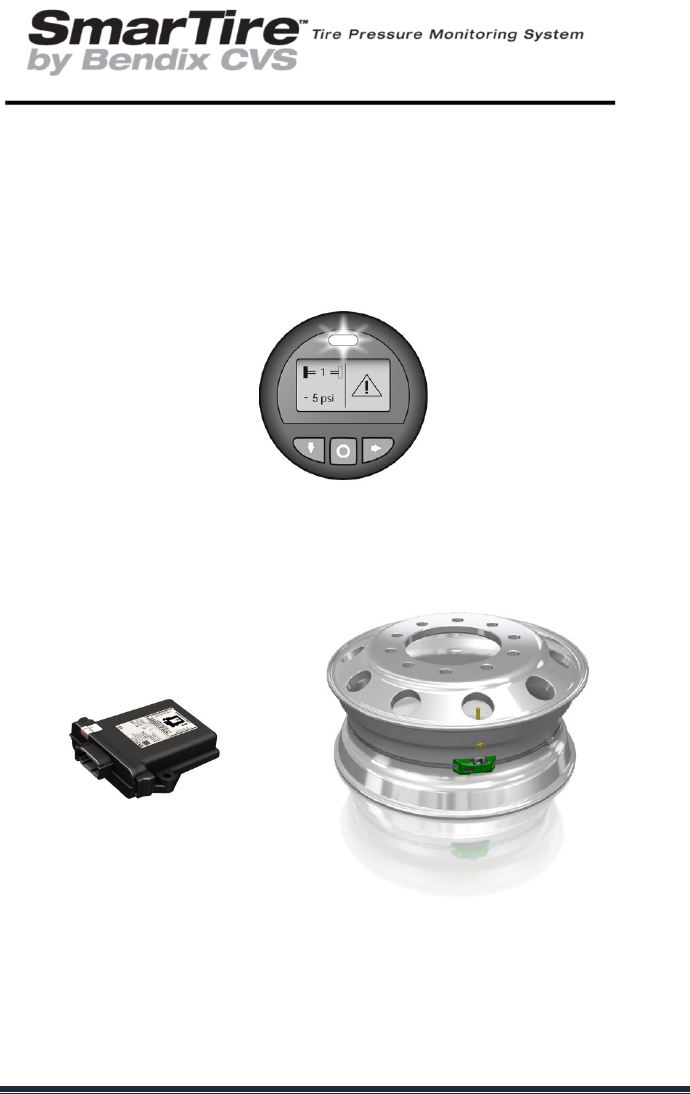
BW8002 Page 1
SmarTire Next GEN TPMS
Operator’s Manual
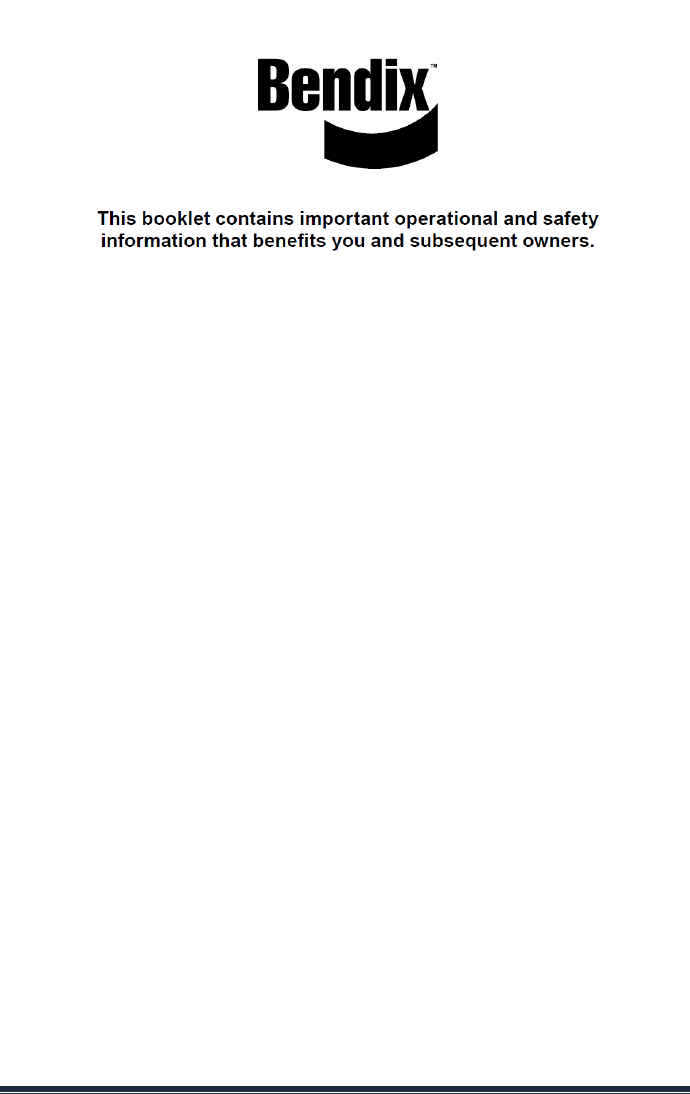
BW8002 Page 2

BW8002 Page 3
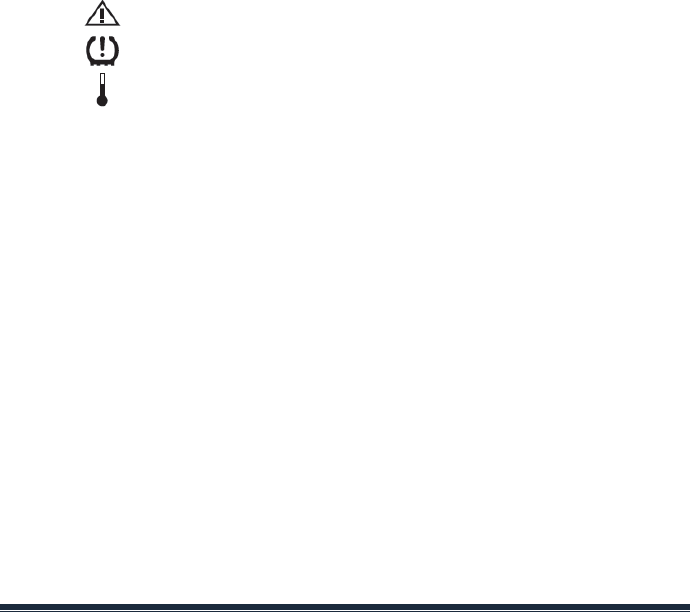
BW8002 Page 4
SMARTIRE™ TIRE PRESSURE MONITORING SYSTEM BY
BENDIX CVS
This vehicle is equipped with a SmarTire™ TPMS (Tire Pressure Monitoring
System) which constantly monitors the pressure and temperature of each tire
on your vehicle in order to provide real-time, on-demand tire status
information and to warn of a tire-related problem before they become
dangerous.
KEY FEATURES OF SMARTIRE™:
Alerts are temperature compensated allowing you to know when
your tires are at risk no matter how long you have been driving or
how hot your tires are.
Real-time tire information displayed on the dash.
Alerts provide immediate visual and optional audible notifications of a
tire problem.
Types of alerts and Icons:
First Level Low/High Pressure Alert
Second Level Critical Low Pressure Alert
High Temperature Alert
Importance of Tire Maintenance
Proper tire maintenance is critically important for keeping tires rolling
smoothly. When properly maintained and inflated, tires will provide shorter
stopping distances, better vehicle handling in emergency situations and
better fuel economy.
Maintenance Tips for Long Tire Life:
Keep tires properly inflated at all times.
Visually inspect tires for injuries prior to each trip.
Match dual tires for size and ensure tire pressures are within 5 PSI of
one another.
Re-tread tires before wear causes excessive belt damage or fatigue.
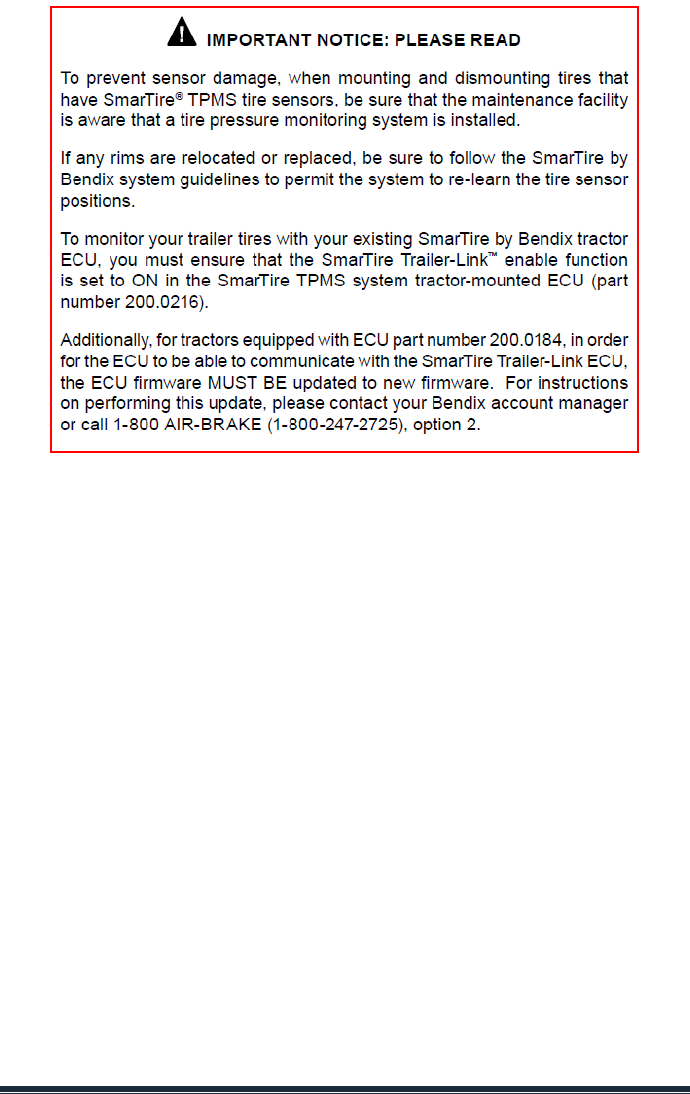
BW8002 Page 5

BW8002 Page 6
Table of Contents
SYSTEM OVERVIEW .............................................................................. 8
SYSTEM LAYOUT AND COMPONENTS.................................................. 8
THE PRESSURE TEMPERATURE RELATIONSHIP .................................... 10
COLD INFLATION PRESSURE (CIP) ................................................... 11
SMARTIRE™ TPMS TEMPERATURE COMPENSATION ........................ 12
SMARTIRE TPMS DISPLAY ................................................................. 14
SCREEN OVERVIEW ........................................................................ 14
SCREEN ICONS ............................................................................... 15
READY SCREEN ICONS ................................................................ 15
ALERT ICONS .............................................................................. 16
USING THE SMARTIRE TPMS SYSTEM ................................................ 17
GETTING STARTED ......................................................................... 17
HOW TO CHECK TIRE PRESSURE, TEMPERATURE AND PRESSURE
DEVIATION ..................................................................................... 18
ALERTS & WARNINGS ......................................................................... 19
REACTING TO ALERTS & WARNINGS ................................................ 19
PRESSURE AND TEMPERATURE ALERTS ........................................... 19
FIRST ALERT LEVEL (FAL): PRESSURE DEVIATION ALERT ............. 19
SECOND ALERT LEVEL (SAL): CRITICAL LOW PRESSURE ALERT .... 20
HIGH TEMPERATURE ALERT ......................................................... 20
OTHER ALERTS AND WARNINGS ...................................................... 21
SENSOR FAULT ALERT ................................................................ 21
LOW SENSOR BATTERY ALERT .................................................... 21
NO TIRES PROGRAMMED ALERT .................................................. 22
QUICK SMARTIRE SYSTEM TROUBLESHOOTING ................................... 24
TROUBLESHOOTING TABLE .............................................................. 24
SENSOR FAULT TROUBLESHOOTING FLOW CHART ........................... 25
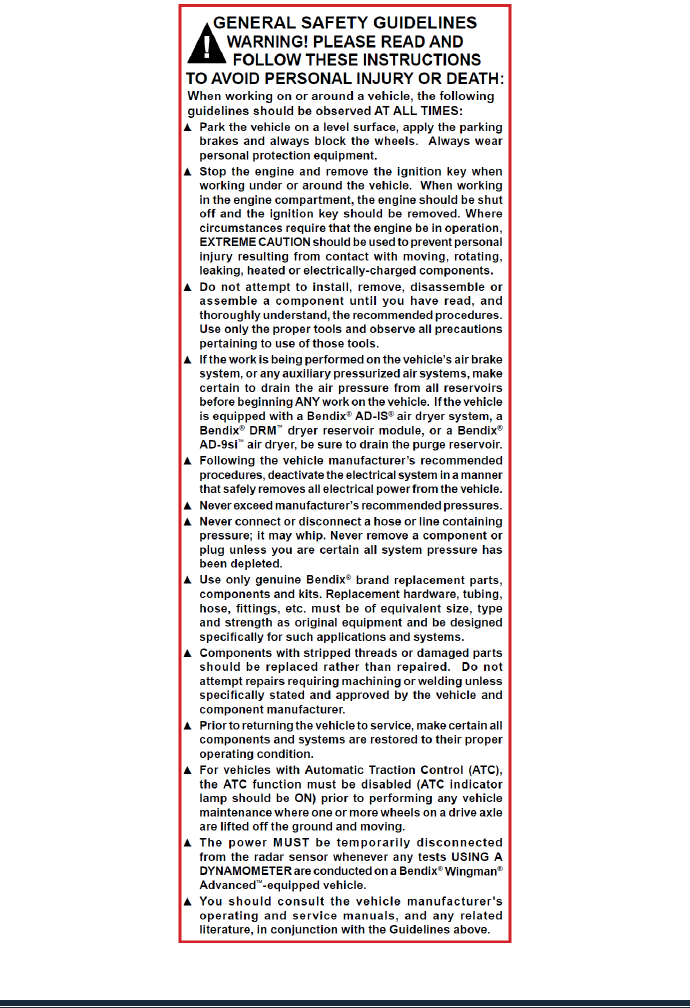
BW8002 Page 7
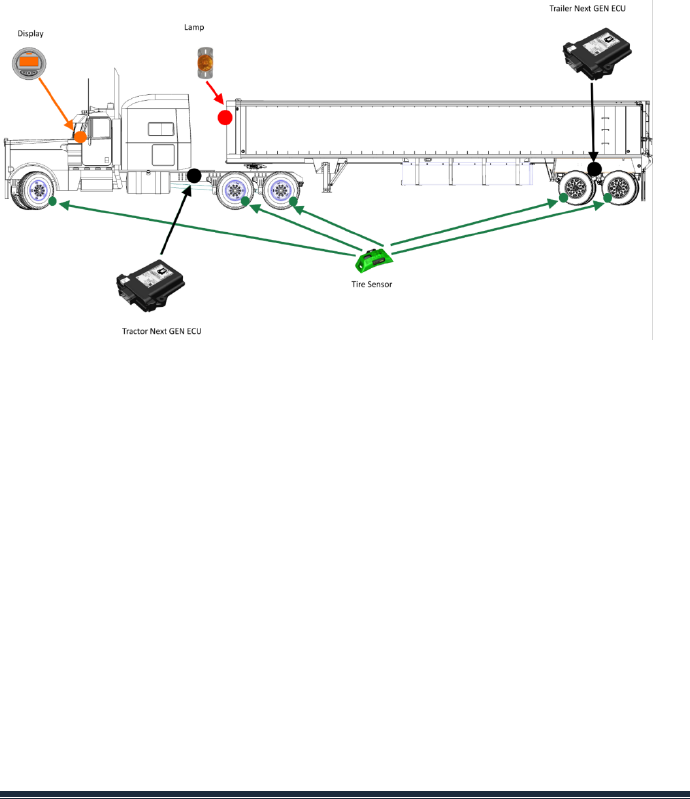
BW8002 Page 8
SYSTEM OVERVIEW
SYSTEM LAYOUT AND COMPONENTS
Tire sensors mounted on each wheel measure tire pressure and temperature
every 12 seconds and wirelessly transmit tire data every three to five minutes
or if the sensor detects a pressure change of +/- 3 PSI, the sensor will
transmit its data immediately. Real-time tire pressure and temperature
information is displayed to the driver on demand via the SmarTire™ display or
an OEM integrated display.
If the tractor is connected to a trailer equipped with a SmarTire Next GEN-
Trailer TPMS system, the trailer tires can also be displayed to the driver.

BW8002 Page 9
A) Next GEN Wireless Receiver/ECU - The Wireless Receiver/ECU forms
the "brain" of the SmarTire™ platform. The receiver captures data
transmissions from tire sensors mounted on each wheel which is then
analyzed against programmed user-defined settings and, if it determines
that a tire is under-inflated or running over temperature, an alert is
triggered.
B) Next GEN for Trailer ECU – The Trailer ECU captures data
transmissions from tire sensors mounted on each trailer wheel. This
data is then analyzed against programmed user-defined settings
contained in the ECU and, if it determines that a tire is under-inflated or
running over temperature, an alert is triggered and relayed to the
Receiver/ECU mounted on the tractor and if equipped with the SmarTire
Display or supported by the OEM dash, displays the alert in the cab of
the tractor.
C) SmarTire Display - Real-time tire pressure and temperature information
is available to the driver on demand via the SmarTire™ display. If the
system detects a tire problem, the display will alert the driver to the
condition so corrective action can be taken.
D) Tire Sensor - The tire sensor measures internal tire pressure and
temperature every 12 seconds and transmits data every three to five
minutes. If the system detects a pressure change of +/- 3 PSI or greater,
it breaks its regular schedule and transmits data immediately. Each tire
sensor is mounted in a break away cradle so that in the event of in-field
damage, the sensor remains unbroken and the cradle can be replaced
allowing the sensor to be reused.
E) Optional Trailer Lamp - When a tire problem occurs on a connected
trailer, the trailer lamp will indicate it to the driver. The lamp illuminates at
the first sign of trouble, as well as flashes to indicate the type of problem
found during power up.

BW8002 Page 10
THE PRESSURE TEMPERATURE RELATIONSHIP
WHY IS IT IMPORTANT? Air naturally expands when heated and contracts
when cooled. Inside a contained vessel such as a tire, this expansion and
contraction causes a change in contained air pressure. As a tire heats up,
its pressure will naturally increase and as it cools down, its pressure
will naturally decrease.
Tire manufacturers specify that tire pressures should be checked and
adjusted when a tire is “cold”, but most people may not know why, or even
what a “cold tire” is. The temperature of a tire has a significant impact on its
inflation pressure.
According to tire manufacturers, a tire is considered to be “cold” when its
temperature is 65°F (18°C). The recommended inflation values provided by
vehicle manufacturers, fleet maintenance personnel or published load
inflation tables are called ‘Cold Inflation Pressures’ (CIP) because they
represent the correct amount of pressure a tire should be inflated to when it
is “cold”. The reason that tires have cold inflation pressures set at specific
temperatures is because a tire’s pressure will change relative to its
temperature.
Tire manufacturers never recommend inflating a tire to less than the
specified cold inflation pressure. In extreme cases, the beads of a
commercial tire can unseat if its pressure gets too low resulting in a
catastrophic tire failure.
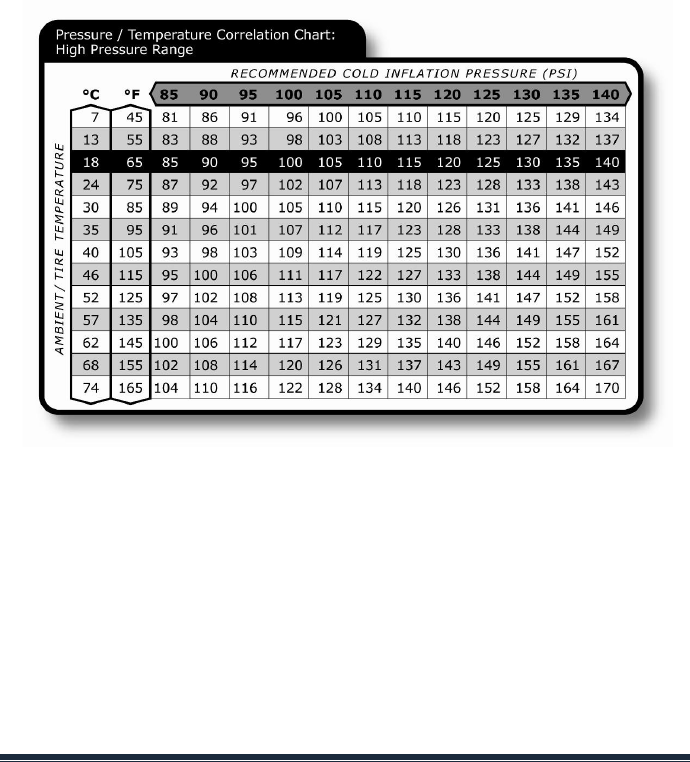
BW8002 Page 11
COLD INFLATION PRESSURE (CIP)
The chart below illustrates the equivalent inflation values for a series of cold
inflation pressures at various temperatures. The temperature values
represent the temperature of the air contained inside the tire. This
temperature can be estimated for a cold tire using the outside, ambient
temperature.
Note: The Figure 1 is to be used as a guide only. Always refer to the tire
or vehicle manufacturer’s recommendations for minimum cold inflation
pressures.
Figure 1
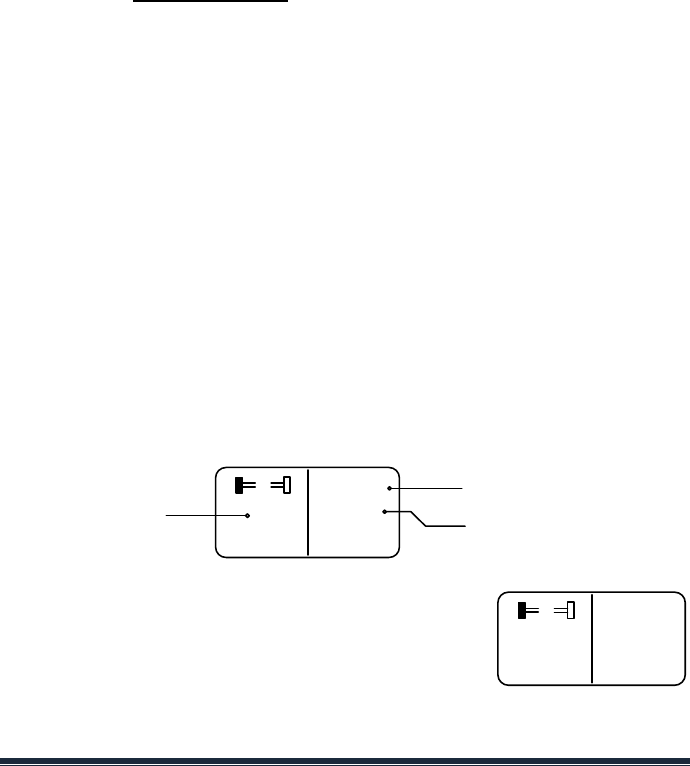
BW8002 Page 12
SMARTIRE™ TPMS TEMPERATURE COMPENSATION
Since a tire’s contained air pressure naturally increases as a vehicle moves,
it can be difficult to tell if a hot tire is under-inflated. Without some form of
temperature compensation, a hot tire that is under- inflated might appear to
be fine because it’s contained air pressure is at or above its cold inflation
pressure (CIP).
When checked using a handheld gauge or a tire monitoring system that does
not measure operating temperature, an under-inflated tire can appear to be
normal. When equipped with SmarTire™ TPMS tire sensors mounted
inside the tire measure both tire pressure and temperature in order to
provide “Temperature Compensated” pressure deviation values and
alerts. The Deviation Value represents the amount of over or under
inflation based on the tire’s current temperature. This value can be used to
warn the driver of an under-inflated tire even if that tire’s actual contained air
pressure is at or above its CIP. This value is also useful when maintaining
the tire as it respresents how much air should be added or removed from the
tire to bring it to the desired pressure, which the system calculates based on
the programmed CIP value and the tire’s current temperature.
The advantages of temperature compensation are even more dramatic when
a tire has a slow leak. Since the leak is slow, the tire may appear over an
extended period of time to be properly inflated when it is actually dangerously
under-inflated and operating well above its temperature capacity. Eventually,
the tire will become so hot that its structure will degrade and then fail in the
form of a blow-out and / or tire fire.
To further illustrate this concept, on the SmarTire display you may see that
the pressure is above the CIP, but due to the temperature of the tire, the
pressure is actually low or high depending on the Deviation value. The image
below shows a tire with a CIP value of 110 PSI at ambient temperature. This
is a properly aired tire and therefore the deviation value displayed is zero.
1
0
psi
65°F
110
psi Tire Air Pressure
Pressure Deviation
(Temperature
Compensated)
Tire Air Temperature
As the vehicle is driven and the tires warm up, the
pressure measured will change due to this natural
increase in the temperature. The Pressure Deviation
value compensates for this change in temperature
and displays a zero value for a properly air tired.
1
0
psi
85°F
115
psi

BW8002 Page 13
Now consider an example where the tire is low. Again, due to this natural
increase in pressure due to temperature as the tire warms up, the actual air
pressure of the tire may appear to be correct
because it is at 110 PSI which is the correct CIP, but
in reality due to the increased temperature of the tire,
the pressure is actually 5 PSI low. The image to the
right shows what would be shown on the display.
The pressure deviation value would indicate the
amount of under inflation based on the temperature compensated value as
described above. In this case, the Deviation Value is shown as - 5, meaning
the tire is 5 psi low and should inflated to 115 PSI. If this value were +5, the
tire would be 5 PSI high for this temperature.
The Pressure Deviation value is a useful tool in maintaining tire
pressures as it takes the guess work out of inflating tires, simply add
the amount of air indicated until this value is 0 and your tires will be
properly inflated!
1
- 5
psi
85°F
110
psi
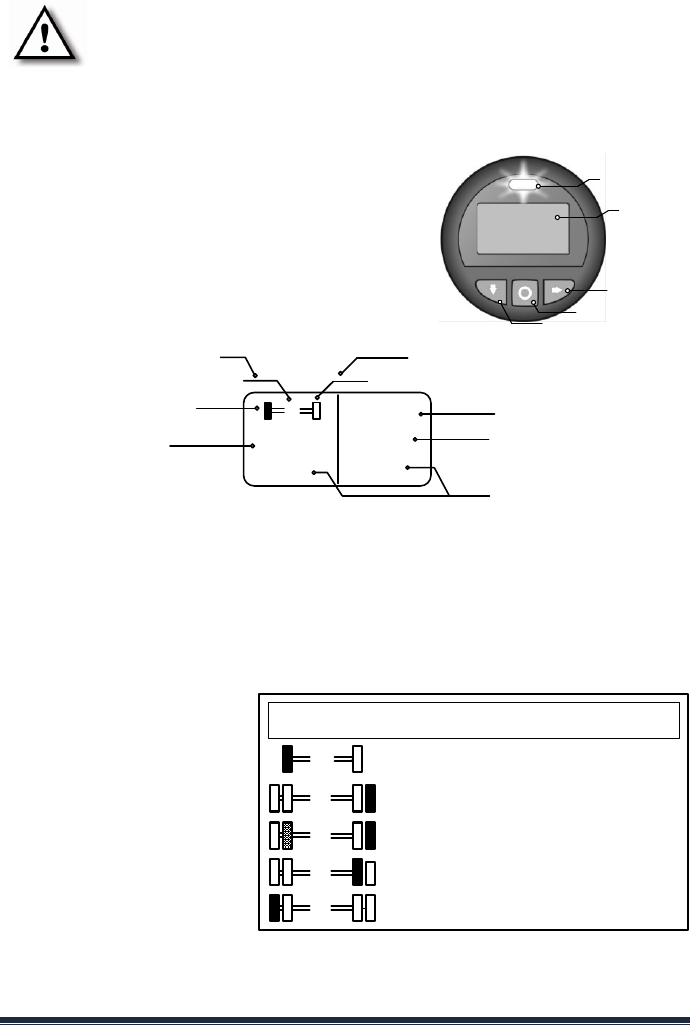
BW8002 Page 14
SMARTIRE TPMS DISPLAY
Note: The following directions apply if vehicle is equipped
with SmarTire display. For OEM please refer to the vehicle
manual for further instructions.
SCREEN OVERVIEW
SmarTire displays tire status information by axle using various axle screens.
Each axle programed in the display has a
corresponding axle screen.
The image below outlines the different screen
elements.
Axle Designator – This number represents the location of the axle you are
viewing. The first axle on your vehicle starting at the front of the vehicle is
“Axle 1”, the next axle is “Axle 2” and so forth. If you are towing a trailer
equipped with SmarTire Trailer-Link TPMS, the trailer axles will be shown
after the last axle on the tractor and will be displayed with a “T” in front of the
number. For example the first axle on a trailer will be shown as “T1”. Just as
with the tractor axles, the axles are numbered from the front of the trailer to
the back so the second
axle is displayed as “T2”.
Tire Icon – This Icon
indicates the axle’s tire
configuration. One box on
each side indicate single
tires, two boxes on each
side indicate dual tires.
Selected Tire Icon – This
indicates which tire is selected and which tire data is actively displayed on
the screen (Pressure, Temperature and Deviation Value).
1
- 5
psi
64°F
110
psi
Tire Air Pressure
Pressure Deviation
(Temperature
Compensated)
Tire Air Temperature
Units of Measure
Selected Tire Icon
Axle Designator Tire Icon
Screen Overview
Left Side Tires Right Side Tires
LED for Alerts
Screen
Right Button
Center Button
Left Button
Single Tire Axle
1
2 Dual Tire Axle
2 Sensor Missing
2Dual Tire
Imbalance
T1 Trailer Axle
Axle Designation, Tire and Selected Tire Legend
Left Tire Selected
Right Outer Dual
Selected
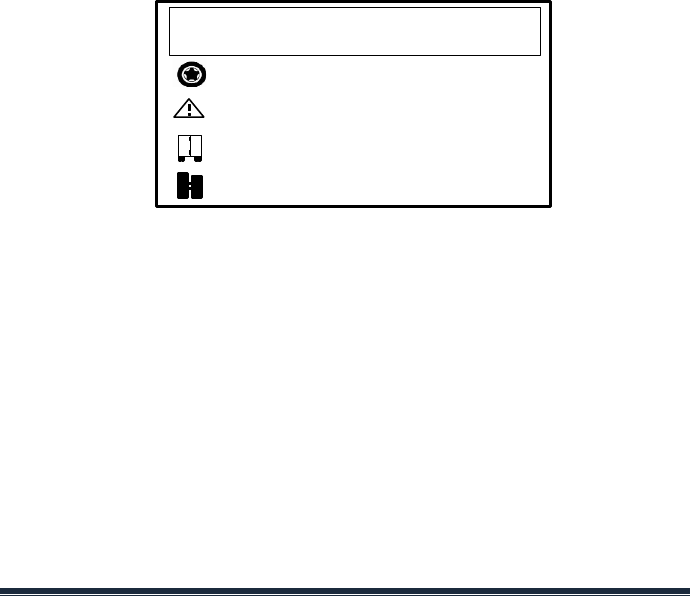
BW8002 Page 15
Pressure Deviation Value - The pressure deviation value indicates the
amount of under or over inflation. When the indicator has a + 5, it means 5
PSI of air should be removed and when it’s - 5, it means 5 PSI of air should
be added.
Tire Air Temperature – This value indicates the current internal air
temperature for the selected tire. Temperature may be shown in degrees F or
C.
Tire Air Pressure – This value indicates the current pressure value for the
selected tire. This is the actual pressure value and is not temperature
compensated.
Units of Measure – Indicates the units the pressure value is displayed in.
This may be set to PSI, BAR, or kPa. Operation
SCREEN ICONS
READY SCREEN ICONS
Ready Screen Icons
TPMS Ready
Active Alert Present
Trailer Connected
Active Dual Tire Imbalance Present
Wheel Icon – This icon appears on the TPMS Ready Screen and indicates
the system is ready and active.
Triangle – When shown on the TPMS Ready Screen, this icon indicates an
active alert is present.
Trailer – This icon indicates a Trailer-LinkTM TPMS system is wirelessly
connected to the tractor ECU and indicates trailer data is available.
Dual Tire – This icon appears on the TPMS ready screen and indicates an
active dual tire imbalance is present. This icon is also shown on the
individual axle screen and indicates the wheel end where the imbalance is
present.

BW8002 Page 16
ALERT ICONS
Alert Icons
First Level Alert (FAL)
Second Level Pressure Alert (SAL)
High Temperature Alert
Sensor Low Battery
Triangle –When displayed on the individual axle screen, this icon indicates a
First Level Alert (FAL) is active.
Tire with Exclamation Point - This icon is shown on the individual axle
screen and indicates a Second Level Alert (SAL)/Critical Low Pressure Alert
is active.
Thermometer – This icon is shown on the individual axle screen and
indicates a High Temperature Alert is active.
Low Battery – This icon is shown on the individual axle screen and indicates
a sensor with a low battery.
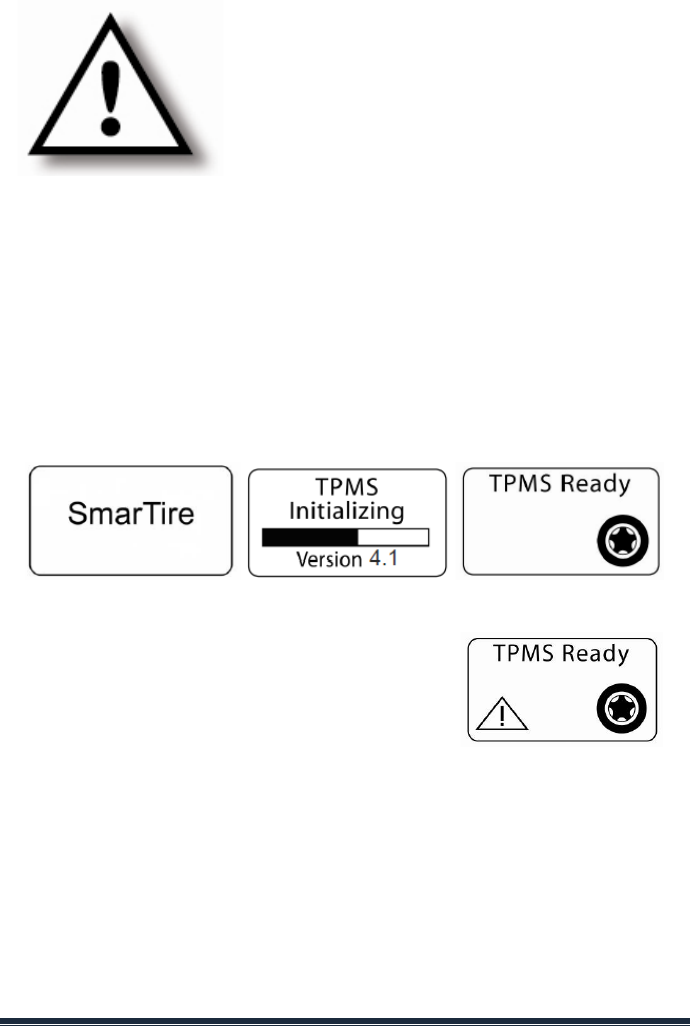
BW8002 Page 17
USING THE SMARTIRE TPMS SYSTEM
NOTE: It is normal for the TPMS system to
take up to 5 minutes for all tire sensor data to
be received and displayed to the driver as the
sensors transmit data every 3-5 minutes. In
some instances the tire could be in a position
where the sensor signal could be blocked and
not seen by the receiver. In this case, after 35
minutes of not seeing a sensor, the system
will issue a Sensor Fault Alert for that
location. If a Sensor Fault Alert occurs and does not clear after the
vehicle is driven, please report this condition to your maintenance
personnel as it may indicate a problem with the system.
GETTING STARTED
When the vehicle’s ignition switch is turned on, the SmarTire™ system will
power up and the display will indicate that the system is initializing. After a
short period, the display will show the “TPMS Ready” screen indicating that
the system is ready to receive tire data from the sensors.
If an Alert icon (triangle with an exclamation
mark) is displayed and the LED light is
illuminated when the TPMS Ready screen is
shown, this is an indication that an active
alert has been detected and should be
investigated / corrected before the vehicle is
driven. Bendix recommends that tire pressure and temperature conditions
always be corrected before a vehicle is driven to ensure the safety of the
driver, vehicle and cargo.
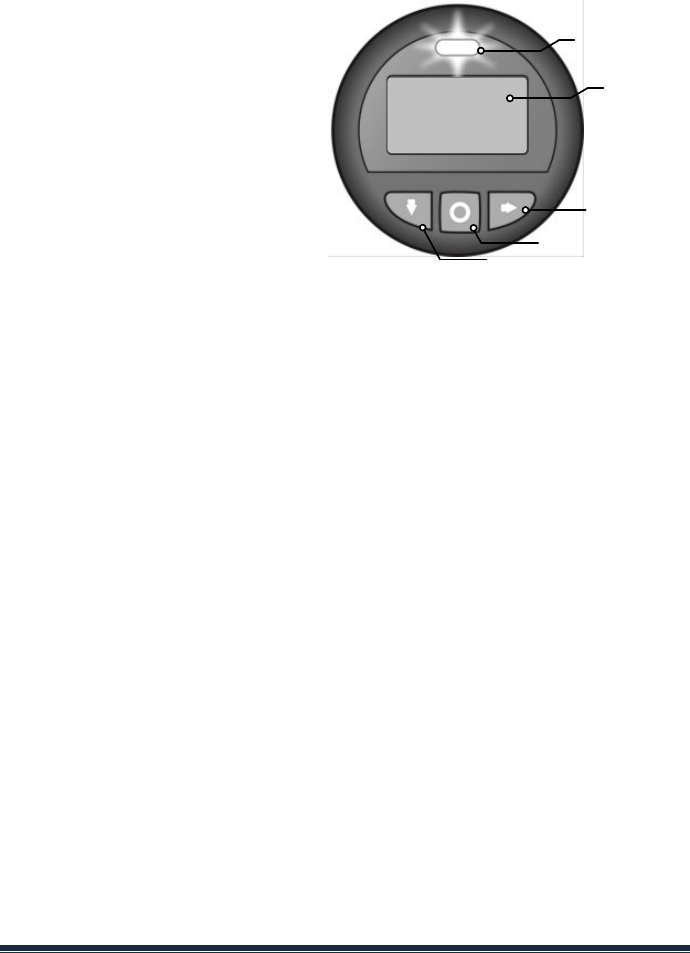
BW8002 Page 18
HOW TO CHECK TIRE PRESSURE, TEMPERATURE AND PRESSURE
DEVIATION
You can navigate through the SmarTire display by following the steps below.
1. Starting from the TPMS
Ready Screen, press the right
button once and the display
will show the first axle screen
starting at the front of the
vehicle with left tire position
highlighted. The pressure,
temperature and pressure
deviation values are then
displayed for the selected tire.
2. To move to the next wheel on
the axle, press the right button
once. Each time the right button is pushed, the next tire in sequence will
be selected and its information displayed. Pressing the right button when
the last tire on the axle is selected will re-select the first tire on that axle.
3. To move to the next axle on the vehicle, press the left button once. Once
again, pressing the right button will scroll the display to the next tire on
that axle. Each time the left button is pressed the display will show the
next axle on the vehicle. When the left button is pressed from the last
axle screen, the first axle will once again be shown. To exit back to the
“TPMS Ready” screen, press the center button once.
LED for Alerts
Screen
Right Button
Center Button
Left Button
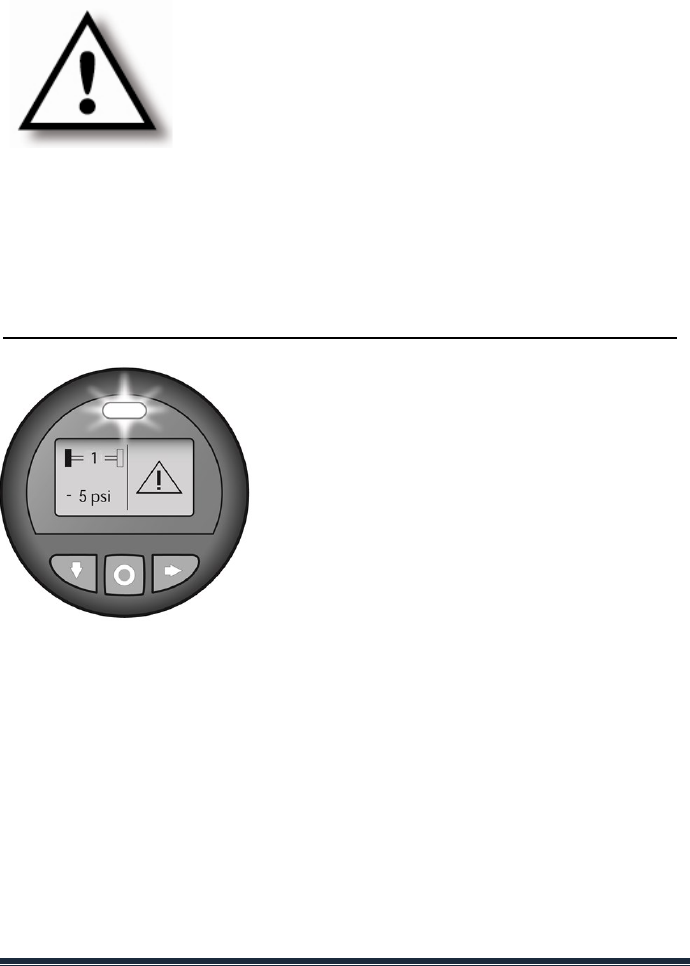
BW8002 Page 19
ALERTS & WARNINGS
REACTING TO ALERTS & WARNINGS
IMPORTANT: It is important to always react to the
alerts and warnings provided by the SmarTire TPMS
(Tire Pressure Monitoring System). It is
recommended that tire conditions always be
corrected as soon as possible and before the
vehicle is driven. Once the pressure is restored or
the temperature is reduced, the alert will
automatically turn off.
PRESSURE AND TEMPERATURE ALERTS
FIRST ALERT LEVEL (FAL): PRESSURE DEVIATION ALERT
Indicated By: Flashing LED Light, Alert Triangle, + or - Deviation Value.
This alert is intended to give you an early
indication that the tire is low/high. This alert is
typically based on the temperature
compensated value (if temperature
compensation is selected for the alert). If so,
you may see that the pressure is above the
CIP, but due to the temperature of the tire, the
pressure is actually low or high depending on
the deviation value showed.
The axle designator and the highlighted wheel
position indicate the position of the tire that is
under- or over-inflated. The pressure deviation value indicates the amount of
under (-), or over (+) inflation that should be corrected.
To acknowledge this alert and return to the TPMS ready screen, press any
button. The LED will stop flashing but remain illuminated until the problem is
corrected. To correct the problem, add or remove air to the affected tire as
indicated by the deviation value. When the deviation value is 0 the tire is
properly inflated.
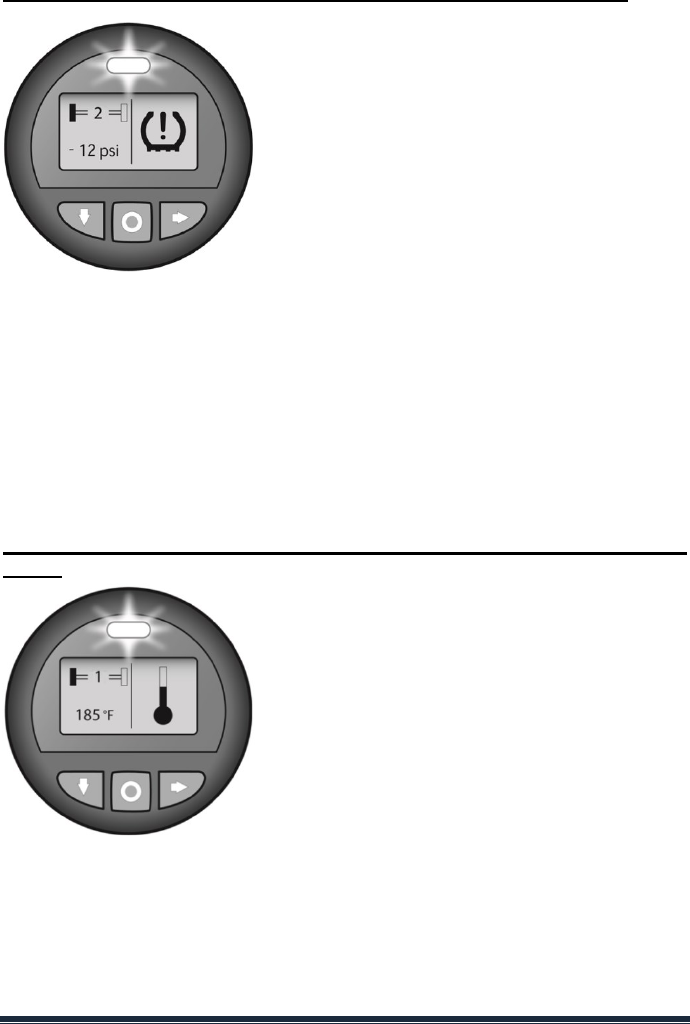
BW8002 Page 20
SECOND ALERT LEVEL (SAL): CRITICAL LOW PRESSURE ALERT
Indicated By: Flashing LED Light, Alert Tire Icon, Deviation Value.
This alert is intended to give you an indication
that the tire is critically low and needs
immediate attention to prevent a critical
failure.
The axle designator and the highlighted wheel
position indicates the tire that is under inflated.
The pressure deviation value indicates the
amount of under- or over-inflation.
IMPORTANT: This alert indicates that the tire is critically underinflated
and should be addressed immediately.
To acknowledge this alert and return to the TPMS ready screen, press any
button. The LED will stop flashing but remain illuminated until the problem is
corrected. To correct the problem add air to the affected tire as indicated by
the deviation value. When the deviation value is 0 the tire is properly inflated.
HIGH TEMPERATURE ALERT
Indicated by: Flashing LED Light, Alert Thermometer, Temperature
Value.
This alert is intended to give you an indication
that the temperature of the air in the tire has
reached a critical point and should be
investigated.
The axle designator and the highlighted wheel
position indicates the tire that is critically hot.
High tire temperatures are typically caused by
under-inflation and the system will usually
provide a pressure alert in advance of a
temperature alert. If triggered on its own, this
alert can be an indication of an alternative
problem, such as a dragging brake or a bearing failure.
To acknowledge this alert and return to the TPMS ready screen, press any
button. The LED will stop flashing but remain illuminated until the problem is
corrected. To correct the problem investigate what is causing the elevated
temperature.
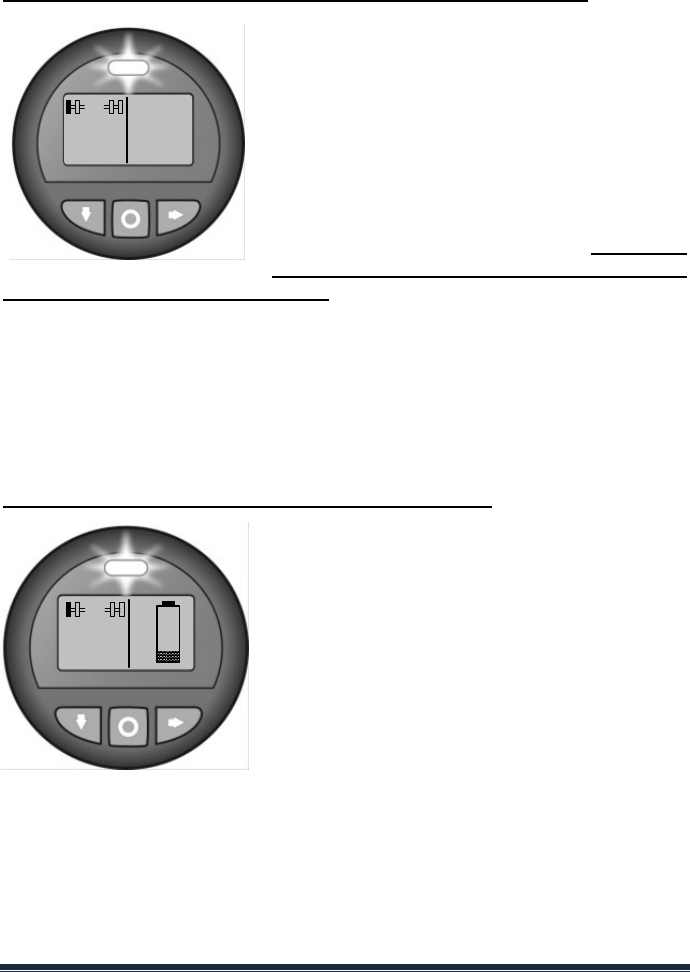
BW8002 Page 21
OTHER ALERTS AND WARNINGS
SENSOR FAULT ALERT
Indicated by: Flashing LED Light, Sensor Fault Alert Message
A Sensor Fault Alert will be issued for any
programmed sensor for which the
Receiver/ECU has not received data for a
predetermined time. Typically, this time is set
to 35 minutes. Sensor Fault Alerts are self-
clearing as soon as data is received from the
given sensor. Prolonged Sensor Fault Alerts
can be an indicator of damaged or missing
sensors and should be addressed to ensure
the system is functioning properly. Tires with
active Sensor Faults cannot provide
pressure and temperature alerts. Sensor Fault Alerts may also appear
when the vehicle is stopped and idling for an extended period of time. Due to
the nature of RF signals, the reception from a tire sensor may be blocked
when the vehicle is stationary. If the fault occurs and does not clear after
the vehicle is driven, please report this condition to maintenance
personnel as it may indicate there is a damaged or missing sensor.
LOW SENSOR BATTERY ALERT
Indicated by: Flashing LED Light, Battery Alert Icon
Typically, a low sensor battery alert will be
triggered when the battery reaches 2.1 Volts
and below. This alert indicates that the sensor
should be replaced as soon as possible before
the battery dies and the sensor stops
transmitting. If not replaced, once a sensor
stops transmitting, after 35 minutes a Sensor
Fault will be activated for that tire location and
prevent pressure and temperature alerts from
being issued for the tire location.
2
SENSOR
FAULT
2+
-
X.XX
Volts

BW8002 Page 22
NO TIRES PROGRAMMED ALERT
Indicated by: Flashing LED Light, No Tires Programed Alert Message
This message will be displayed after the
startup sequence if the Receiver/ECU has not
been programmed with any axle and wheel
configurations. In this case the system is
not functioning and no pressure or
temperature alerts will be displayed. This
should be reported to maintenance to be
corrected as soon as possible.
NO TIRES
PROGRAMMED

BW8002 Page 23

BW8002 Page 24
QUICK SMARTIRE SYSTEM TROUBLESHOOTING
TROUBLESHOOTING TABLE
Note: If problem continues report to maintenance.
ORDER OF TROUBLESHOOTING
Problem
X
X X X X X X
Several
tires are
reporting
sensor
Diagnostic
Trouble
Codes
Actions to
be taken
Turn ignition off & on
Wait 5 minutes after
key on for data to be
received
X
Gauge is
not
initializing
Dashes
displayed
on gauge
Gauge
shows a
Pressure or
Temperatur
e Alert
Tire
pressure is
not being
updated
after
pressure
correction
(greater
than 3PSI)
Tire
pressure
value is
decreasing
over time
Gauge
shows
Sensor
Fault Alert
X
X
Signal may not be
received, move the
vehicle to reposition
the sensor
X
X
X
X
X
Go to the section
“Pressure and
Temperature Alerts
& Warnings”.
(Page 7) and follow
the indications for the
specific alert.
X
The tire is exhibiting
a slow leak. Take
appropriate steps to
have the tire
inspected for any
damage or leaks.
X
Report to
maintenance
Follow the
indications on
Sensor Fault
Troubleshooting
(Page 12)
X

BW8002 Page 25
SENSOR FAULT TROUBLESHOOTING FLOW CHART
Is the Sensor Fault
intermittent or constant? For
example, does the fault go
away after driving or always
stay on?
Have the tires been
serviced prior to the
sensor fault becoming
active?
Wait 3-5 minutes after key on for data
to be received. Issue resolved?
Move the vehicle to reposition the
sensor and wait 3-5 min for next
transmission. Issue resolved?
Is the gauge
displaying a Sensor
Fault?
YES
NO
CONSTANT
If this happens frequently, this may
indicate a system issue, Report to
Maintenance.
Has the vehicle been
idling for more than 35
minutes with the ignition
power “ON”?
INTERMITTENT
Does the fault clear
away after driving
again?
YES
NO
Sensor Fault Cleared
YES
YES
Driver Sensor Fault Troubleshooting
YES
This is an indication that either a
sensor was not replaced during
servicing or the new ID code was
not programmed. Report to
Maintenance.
YES
This is an indication of missing
sensor, mis-programmed sensor ID
code, or reception issue. Report to
Maintenance.
NO
NO
Report to Maintenance.
NO
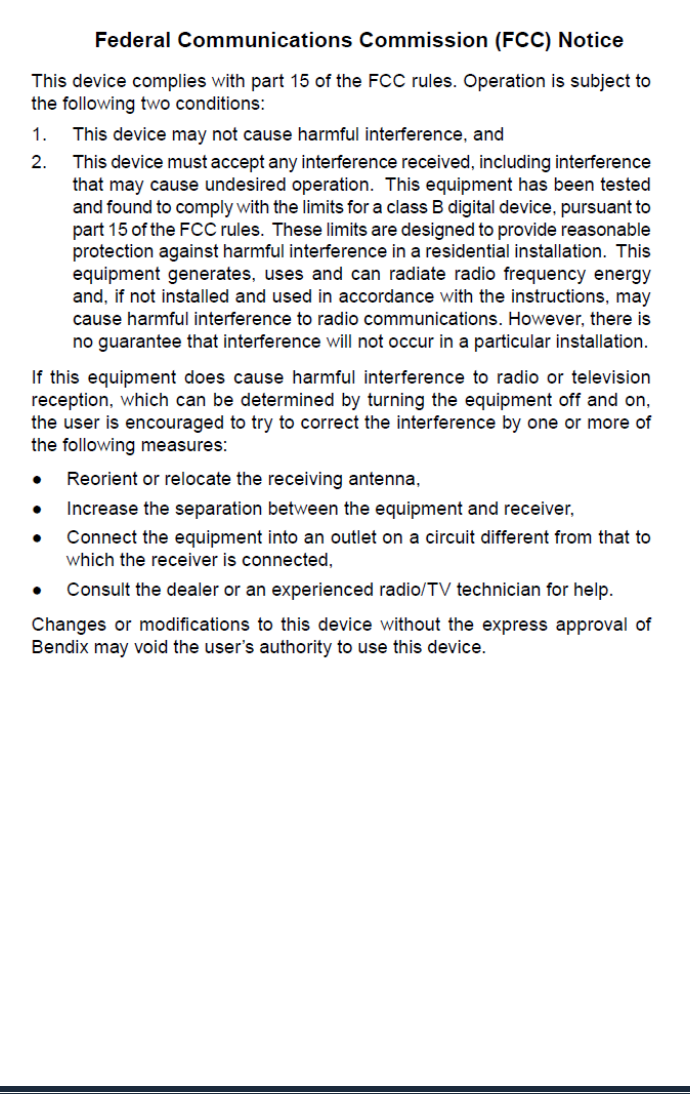
BW8002 Page 26

BW8002 Page 27
This device complies with Industry Canada’s license-exempt RSSs. Operation is
subject `to the following two conditions:
(1) This device may not cause interference; and
(2) This device must accept any interference, including interference that may cause
undesired operation of the device.
Cet appareil est conforme aux RSS exempts de licence d'Industrie Canada.
L'opération est soumise aux deux conditions suivantes:
(1) Cet appareil ne doit pas causer d'interférences; et
(2) Cet appareil doit accepter toute interférence, y compris les interférences
susceptibles de provoquer un fonctionnement indésirable de l'appareil.
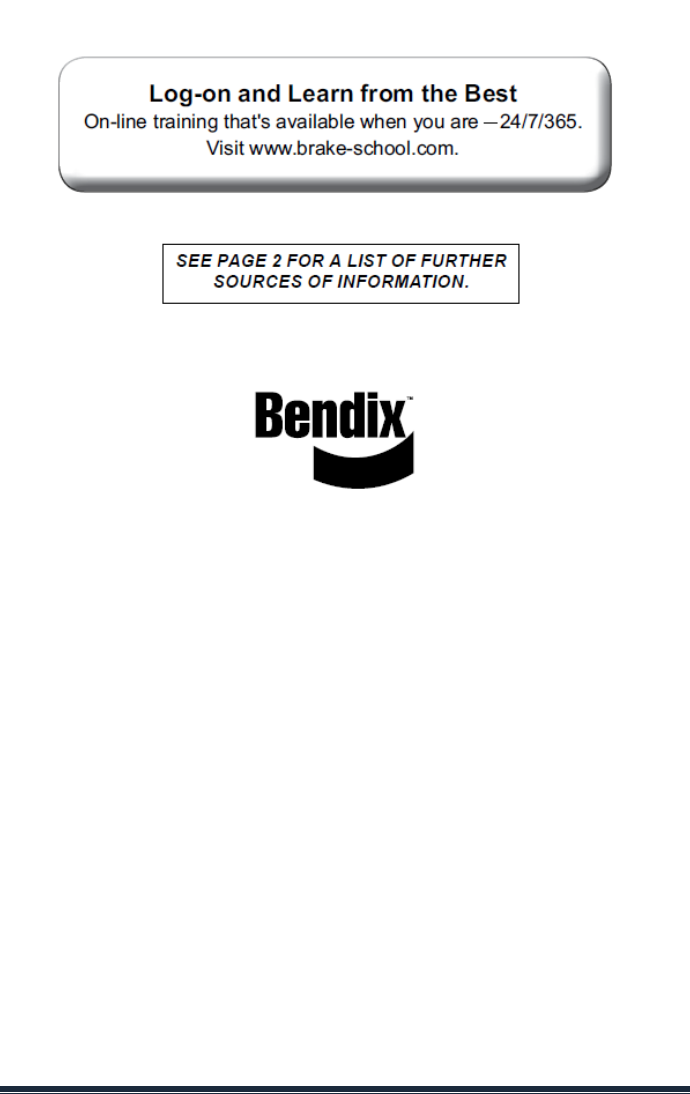
BW8002 Page 28